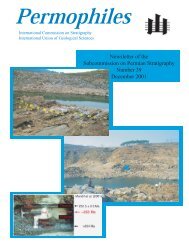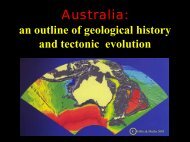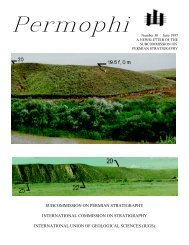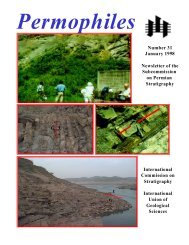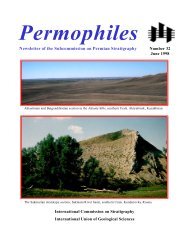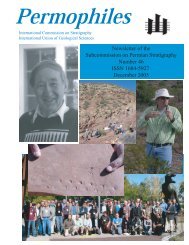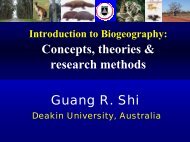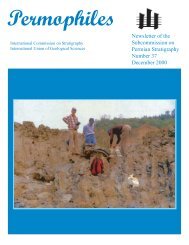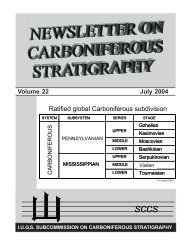Newsletter of the Subcommission on Permian Stratigraphy Number ...
Newsletter of the Subcommission on Permian Stratigraphy Number ...
Newsletter of the Subcommission on Permian Stratigraphy Number ...
Create successful ePaper yourself
Turn your PDF publications into a flip-book with our unique Google optimized e-Paper software.
Progress <strong>on</strong> <str<strong>on</strong>g>the</str<strong>on</strong>g> definiti<strong>on</strong> for <str<strong>on</strong>g>the</str<strong>on</strong>g> base <str<strong>on</strong>g>of</str<strong>on</strong>g> <str<strong>on</strong>g>the</str<strong>on</strong>g>ChanghsingianShil<strong>on</strong>g MeiChina University <str<strong>on</strong>g>of</str<strong>on</strong>g> Geosciences, Beijing, China and University <str<strong>on</strong>g>of</str<strong>on</strong>g>CalgaryCharles Henders<strong>on</strong>Department <str<strong>on</strong>g>of</str<strong>on</strong>g> Geology and Geophysics, University <str<strong>on</strong>g>of</str<strong>on</strong>g> Calgary,Calgary, Alberta, CanadaBruce WardlawU.S. Geological Survey, Rest<strong>on</strong>, Virginia, USAChangqun CaoNanjing Institute <str<strong>on</strong>g>of</str<strong>on</strong>g> Geology and Pale<strong>on</strong>tology, Academia Sinica,39 East Beijing Road, Nanjing, ChinaWe would like to report that significant progress has beenmade regarding a potential GSSP for <str<strong>on</strong>g>the</str<strong>on</strong>g> base <str<strong>on</strong>g>of</str<strong>on</strong>g> <str<strong>on</strong>g>the</str<strong>on</strong>g>Changhsingian. This progress is based <strong>on</strong> <str<strong>on</strong>g>the</str<strong>on</strong>g> analysis <str<strong>on</strong>g>of</str<strong>on</strong>g>new c<strong>on</strong>od<strong>on</strong>t collecti<strong>on</strong>s from near <str<strong>on</strong>g>the</str<strong>on</strong>g> base <str<strong>on</strong>g>of</str<strong>on</strong>g> <str<strong>on</strong>g>the</str<strong>on</strong>g>Changxing Formati<strong>on</strong>. The evoluti<strong>on</strong> <str<strong>on</strong>g>of</str<strong>on</strong>g> <str<strong>on</strong>g>the</str<strong>on</strong>g> denticulati<strong>on</strong>around <str<strong>on</strong>g>the</str<strong>on</strong>g> boundary between <str<strong>on</strong>g>the</str<strong>on</strong>g> L<strong>on</strong>gtan Formati<strong>on</strong> and<str<strong>on</strong>g>the</str<strong>on</strong>g> Changxing Formati<strong>on</strong> in <str<strong>on</strong>g>the</str<strong>on</strong>g> D secti<strong>on</strong> can be characterizedwithin populati<strong>on</strong>s <str<strong>on</strong>g>of</str<strong>on</strong>g> adult specimens. Small, juvenileforms generally show more discrete denticles than large,adult forms, and are similar throughout <str<strong>on</strong>g>the</str<strong>on</strong>g> ChangxingLimest<strong>on</strong>e. Very large, ger<strong>on</strong>tic forms display excessivefusi<strong>on</strong> and comm<strong>on</strong>ly pathologic, bizarre characters. In <str<strong>on</strong>g>the</str<strong>on</strong>g>basal part <str<strong>on</strong>g>of</str<strong>on</strong>g> <str<strong>on</strong>g>the</str<strong>on</strong>g> Changxing Limest<strong>on</strong>e, a distinctive changein denticulati<strong>on</strong> c<strong>on</strong>figurati<strong>on</strong> <str<strong>on</strong>g>of</str<strong>on</strong>g> Clarkina Pa elements hasbeen observed in or near bed 4 (sensu Yin et al., 1996).Bed 2:The denticulati<strong>on</strong> in adult Pa elements <str<strong>on</strong>g>of</str<strong>on</strong>g> Clarkina from Bed 2and below show a cusp that is largely reclined and thus low, or ashigh as or a little bit higher than <str<strong>on</strong>g>the</str<strong>on</strong>g> posteriormost denticle. Theanterior slope <str<strong>on</strong>g>of</str<strong>on</strong>g> <str<strong>on</strong>g>the</str<strong>on</strong>g> cusp is gentle and usually 1.5 to 2 times asl<strong>on</strong>g as <str<strong>on</strong>g>the</str<strong>on</strong>g> height <str<strong>on</strong>g>of</str<strong>on</strong>g> <str<strong>on</strong>g>the</str<strong>on</strong>g> cusp. The posteriormost denticle is usuallyc<strong>on</strong>siderably reduced and fused with <str<strong>on</strong>g>the</str<strong>on</strong>g> anterior porti<strong>on</strong> <str<strong>on</strong>g>of</str<strong>on</strong>g><str<strong>on</strong>g>the</str<strong>on</strong>g> cusp to form <str<strong>on</strong>g>the</str<strong>on</strong>g> lowest and narrowest part <str<strong>on</strong>g>of</str<strong>on</strong>g> a posteriorlydeclining carina, forming a wide c<strong>on</strong>cave arc in lateral view. Thisdenticulati<strong>on</strong> cannot be substantially differentiated from that <str<strong>on</strong>g>of</str<strong>on</strong>g>Clarkina l<strong>on</strong>gicuspidata. As a result, Clarkina l<strong>on</strong>gicuspidata istentatively used herein as a species in terms <str<strong>on</strong>g>of</str<strong>on</strong>g> populati<strong>on</strong> c<strong>on</strong>ceptto include morphotypes with various platform outlines, but <str<strong>on</strong>g>the</str<strong>on</strong>g>same denticulati<strong>on</strong> as menti<strong>on</strong>ed above. The specimens in bed 2may differ slightly from somewhat lower specimens <str<strong>on</strong>g>of</str<strong>on</strong>g> Clarkinal<strong>on</strong>gicuspidata.Beds 3 to Lower 4:We do not have specimens from bed 3 at present. This willneed to be documented before a formal definiti<strong>on</strong> can be putforward. Specimens in <str<strong>on</strong>g>the</str<strong>on</strong>g> lower part <str<strong>on</strong>g>of</str<strong>on</strong>g> bed 4 are not comm<strong>on</strong>and appear transiti<strong>on</strong>al in that <str<strong>on</strong>g>the</str<strong>on</strong>g> middle denticles are higher andmore wall-like, but a gap sometimes exists between <str<strong>on</strong>g>the</str<strong>on</strong>g> cusp andposteriormost denticle.Beds Upper 4 to 9:The denticulati<strong>on</strong> in adult Pa elements <str<strong>on</strong>g>of</str<strong>on</strong>g> Clarkina from UpperBed 4 to Bed 9 (sensu Yin et al., 1996) has posterior denticles thatare not reduced and a cusp that is not clearly separated from <str<strong>on</strong>g>the</str<strong>on</strong>g>Permophiles Issue #38 200137carina that bears largely fused denticles. As a result, <str<strong>on</strong>g>the</str<strong>on</strong>g> carina inlateral view keeps <str<strong>on</strong>g>the</str<strong>on</strong>g> same height towards <str<strong>on</strong>g>the</str<strong>on</strong>g> end <str<strong>on</strong>g>of</str<strong>on</strong>g> <str<strong>on</strong>g>the</str<strong>on</strong>g> platformand looks like a high “wall”. Specimens with this type <str<strong>on</strong>g>of</str<strong>on</strong>g> denticulati<strong>on</strong>,but with different shapes <str<strong>on</strong>g>of</str<strong>on</strong>g> platform outline were tentativelynamed as Clarkina prechangxingensis (roundmorphotype),C. wangi (narrow-morphotype), C. predeflecta(square-morphotype) and C. subcarinata (transiti<strong>on</strong>al mophotype)by Mei et al. (1998) in an attempt to c<strong>on</strong>solidate <str<strong>on</strong>g>the</str<strong>on</strong>g> disparatemorphologic form taxa identified previously. Based <strong>on</strong> <str<strong>on</strong>g>the</str<strong>on</strong>g> holotypes<str<strong>on</strong>g>of</str<strong>on</strong>g> morphospecies we apply <str<strong>on</strong>g>the</str<strong>on</strong>g> names Clarkina wangi to<str<strong>on</strong>g>the</str<strong>on</strong>g> forms with <str<strong>on</strong>g>the</str<strong>on</strong>g> high, wall-like carina, and Clarkina subcarinata(sensu strictu) to <str<strong>on</strong>g>the</str<strong>on</strong>g> forms with a similar denticulati<strong>on</strong> to C. wangi,but <str<strong>on</strong>g>the</str<strong>on</strong>g> posterior denticles are usually moderately reduced in heightand partially discrete. This new phylogenetic species c<strong>on</strong>ceptcompletely encompasses <str<strong>on</strong>g>the</str<strong>on</strong>g> holotype and topotypes <str<strong>on</strong>g>of</str<strong>on</strong>g> Clarkinasubcarinata (Sweet, 1973). Clarkina orientalis, <str<strong>on</strong>g>the</str<strong>on</strong>g> most easilyidentifiable Clarkina species for <str<strong>on</strong>g>the</str<strong>on</strong>g> Lopingian, ranges throughBed 2 to Bed 4; it is particularly comm<strong>on</strong> in bed 4, but it is notpresent above. Its distinct denticulati<strong>on</strong> may suggest that it probablybel<strong>on</strong>gs to a different lineage.Metreage in secti<strong>on</strong>:Base <str<strong>on</strong>g>of</str<strong>on</strong>g> bed 2 = 0 mBase <str<strong>on</strong>g>of</str<strong>on</strong>g> bed 4 = 1.48 mTop <str<strong>on</strong>g>of</str<strong>on</strong>g> bed 2 = 0.7 mTop <str<strong>on</strong>g>of</str<strong>on</strong>g> bed 4 = 2.1 mC<strong>on</strong>clusi<strong>on</strong>:The transiti<strong>on</strong> from <str<strong>on</strong>g>the</str<strong>on</strong>g> denticulati<strong>on</strong> <str<strong>on</strong>g>of</str<strong>on</strong>g> Clarkinal<strong>on</strong>gicuspidata to that <str<strong>on</strong>g>of</str<strong>on</strong>g> C. wangi occurs in a very short intervalei<str<strong>on</strong>g>the</str<strong>on</strong>g>r within bed 3 or more likely within bed 4 (about 60 cm) andthus allows us to be able to distinguish <str<strong>on</strong>g>the</str<strong>on</strong>g>se two species fairlyc<strong>on</strong>sistently. The sample from <str<strong>on</strong>g>the</str<strong>on</strong>g> upper part <str<strong>on</strong>g>of</str<strong>on</strong>g> Bed 4 (sensu Yinet al., 1996) yielded abundant adult forms with a high, wall-likecarina, and <str<strong>on</strong>g>the</str<strong>on</strong>g> sample from <str<strong>on</strong>g>the</str<strong>on</strong>g> top <str<strong>on</strong>g>of</str<strong>on</strong>g> Bed 2 (sensu Yin et al, 1996)yielded abundant adult specimens with a denticulati<strong>on</strong> more typical<str<strong>on</strong>g>of</str<strong>on</strong>g> Clarkina logicuspidata. Rare specimens from <str<strong>on</strong>g>the</str<strong>on</strong>g> top <str<strong>on</strong>g>of</str<strong>on</strong>g>Bed 2 have a posteriormost denticle that is not so much reduced,and thus similar to that <str<strong>on</strong>g>of</str<strong>on</strong>g> Clarkina wangi. Samples from Bed 3are still in process. The first occurrence <str<strong>on</strong>g>of</str<strong>on</strong>g> Clarkina wangi shouldbe somewhere within Bed 3 or Bed 4. We suggest that <str<strong>on</strong>g>the</str<strong>on</strong>g> base <str<strong>on</strong>g>of</str<strong>on</strong>g><str<strong>on</strong>g>the</str<strong>on</strong>g> Changhsingian be defined by <str<strong>on</strong>g>the</str<strong>on</strong>g> FAD <str<strong>on</strong>g>of</str<strong>on</strong>g> Clarkina wangi inSecti<strong>on</strong> D at Meishan, Changxing County, China at a point to bedetermined very so<strong>on</strong>.ReferencesMei, Shil<strong>on</strong>g, Zhang, K., Wardlaw, B.R., 1998. A refined z<strong>on</strong>ati<strong>on</strong><str<strong>on</strong>g>of</str<strong>on</strong>g> Changhsingian and Griesbachian neog<strong>on</strong>dolellid c<strong>on</strong>od<strong>on</strong>tsfrom <str<strong>on</strong>g>the</str<strong>on</strong>g> Meishan secti<strong>on</strong>, candidate <str<strong>on</strong>g>of</str<strong>on</strong>g> <str<strong>on</strong>g>the</str<strong>on</strong>g> global stratotypesecti<strong>on</strong> and point <str<strong>on</strong>g>of</str<strong>on</strong>g> <str<strong>on</strong>g>the</str<strong>on</strong>g> <strong>Permian</strong>-Triassic boundary.Palaeogeography, Palaeoclimatology, Palaeoecology, 143 (4),213-226.Sweet W.C., 1973. Late <strong>Permian</strong> and Early Triassic c<strong>on</strong>od<strong>on</strong>t faunas.In: Logan A. and Hills L.V. (eds.), <str<strong>on</strong>g>the</str<strong>on</strong>g> <strong>Permian</strong>-Triassic systemsand <str<strong>on</strong>g>the</str<strong>on</strong>g>ir mutual boundary. Canadian Society <str<strong>on</strong>g>of</str<strong>on</strong>g> PetroleumGeologists, Spec. Publ., 2: 630-646.Yin H., Sweet, W.C., Glenister, B.F., Kotlyar, G., Kozur, H., Newwell,N.D., Sheng, J., Yang, Z. and Zakharov, Y.D., 1996. Recommendati<strong>on</strong><str<strong>on</strong>g>of</str<strong>on</strong>g> <str<strong>on</strong>g>the</str<strong>on</strong>g> Meishan secti<strong>on</strong> as Global Stratotype Secti<strong>on</strong> andPoint for basal boundary <str<strong>on</strong>g>of</str<strong>on</strong>g> Triassic System. Newsl. Stratigr.,34(2): 81-108.



